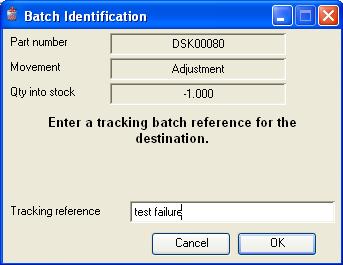Batch Identification
This window opens whenever a tracked part stock change is individually processed and enables you to choose a batch source of the movement and or a tracking reference for the part trace log. Normally the tracking reference is automatically assigned (see below), but in cases where there is no source link, such as a purchase or work order, you will be asked to provide one.
|
Field |
Description |
|---|---|
|
Part number |
Parts Master. Part number unique identifier. {PTMFILE.PTMPTNO char 18} |
|
Batch dropdown list |
List of current batches. This is only visible when appropriate to the transaction. |
|
Tracking reference |
Batch Tracking. Batch trace identifier code: jst(‘D’,1,SAHCUSC,’6X’, SAHDESP,6,SAHLINE,’-3N0P0′) or jst(‘C’,1,SAHCUSC,’6X’, SAHINNO,6,SAHINVL,’-3N0P0′). {TCKFILE.TCKREF char 16} See movement type below. The tracking reference varies with each stock movement type. |
|
Movement type |
Stock Movement History. Movement type. {STHFILE.STHTYPE char 1} |
|
Movement quantity |
Stock Movement History. Quantity of movement (+ = into (or due into) inventory, – = out of inventory). {STHFILE.STHQTY number 3dp} |
|
Button |
Action |
|---|---|
|
Cancel |
Aborts the process currently in session. The keyboard equivalent is the Esc key for Windows computers and Command-.(full stop or period) for the Mac. |
|
OK |
The OK button updates the data you have entered, or confirms the selection and/or processes the function you have called. |
Tracking System
The traceability system in the program works by recording all movements of parts marked as Tracked. Each time a quantity of the part is moved a tracking record is produced with the following information:
|
Field |
Description |
|---|---|
|
Part Number |
The number of the part being processed. |
|
Batch |
The batch number from which or to which the quantity was moved.
|
|
Tracking reference |
A coded reference which can identify the source or destination of the movement. For example, it may identify the Supplier, Purchase Order and Line Item of a receipt. |
|
Transaction type |
A single character code that identifies the process causing the movement. The transaction type is the same as that used in Stock History. |
|
Quantity |
The quantity in stock units of measure of the movement into inventory. If this is negative the movement was out of inventory. |
|
Extended Stock Information |
Length, Width, Units, Date and Comments |
|
Movement (Type) {Qty} |
Batch ID |
Reference |
|---|---|---|
|
SO dispatch (A) {-ve} |
Source |
‘D’,CUSCODE,SAHDESP,SAHLINE or |
|
SO return (B) {+ve} |
New |
‘C’,CUSCODE,SAHIVNO,SAHINVL |
|
Job issue (A) {-ve} |
Source |
‘J’,CUSCODE,JOBCODE,JBILINE |
|
Job return (B) {+ve} |
New |
‘J’,CUSCODE,JOBCODE,JBILINE |
|
PO receipt (C) {+ve} |
New |
‘S’,POLREFor |
|
PO return (D) {-ve} |
Source |
‘S’,SUPCODE,POHPONO,POLLINE |
|
General Issue (E) {-ve} |
Source |
User entered or null |
|
Gen. Return (F) {+ve} |
New |
User entered or null |
|
Outwork issue (G) {-ve} |
Source |
‘S’,SUPCODE,POHPONO,POLLINE |
|
Outwork return (H) {+ve} |
Change qty or delete issue |
|
|
WO kit issue (I) {-ve} |
Source |
‘W’,WKOWONO |
|
WO kit return (J) {+ve} |
Change qty or delete issue |
|
|
WO receipt (K) {+ve} |
New |
‘W’,WKOWONO |
|
Allocation (L) |
||
|
De-allocation (M) |
||
|
Adjustment +ve qty (N) {+ve} |
New |
User entered or null |
|
Adjustment -ve qty (N) {-ve} |
Source |
User entered or null |
|
SO preparation (O) |
||
|
PO preparation (P) |
||
|
WO preparation (Q) |
||
|
Kitting qty adjustment (R) |
||
|
Quarantined (outward) (S) {-ve} |
Source (Non-Quar) if not float |
User entered or null |
|
Released (outward) (T) {-ve} |
Source (Quar) |
User entered or null |
Where:
CUSCODE = Customer code
SAHIVNO = Invoice Number
SAHLINE = Invoice Line Number
SUPCODE = Supplier Code
POHPONO = Purchase Order Number
POLLINE = Purchase Order Line Number
WKOWONO = Work Order Number
New Batch Numbers are constructed from XNNNNNN, where X is the Batch number prefix set in the “System Manager” “Company Details…” and NNNNNN is the next batch serial number.
For +ve qty movements a new batch location is created when received into inventory.
For -ve qty movements the batch location is the source from inventory.
User entered tracking references cannot be prefixed by the characters “C”, “S” or “W” which are reserved for automatic references.
![]() NOTE: The following options can be used to modify the Batch Number and Tracking system operation:
NOTE: The following options can be used to modify the Batch Number and Tracking system operation:
optSOBatchNosInDesc : If set to 1 or YES, Batch Numbers of tracked parts will be appended to the Sales History description and show on invoices.
optStockBatchDateWarn : If set to 1 or YES, a user warning is given on batch selection at the time of dispatch when date-based batch numbers are older than number of days set in PTMUSE2. This enables an expired batch to be identified so that expired stock is not shipped to customers.
optStockBatchNoManual : If set to 1 or YES, the user is permitted to enter a Batch Number for batch tracked items received from a Purchase Order or received from a Work Order. The number must be unique and have a different prefix character to that currently set in the Company Details.
optStockBatchWindowOff when Extended Stock Information system preference is on, will suppress the opening of the New Multi-location for Part window.
| See also: – |
Compiled in Program Version 5.10. Help data last modified 4 Jun 2012 04:48:00.00. Class wTckSingle last modified 18 Feb 2015 01:54:55.


